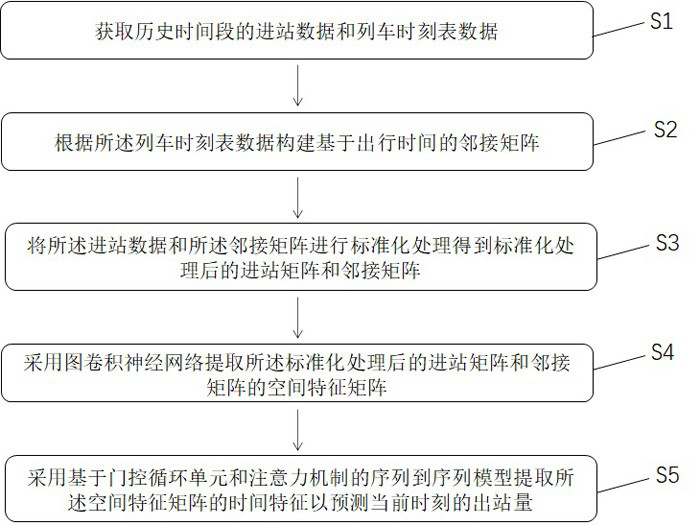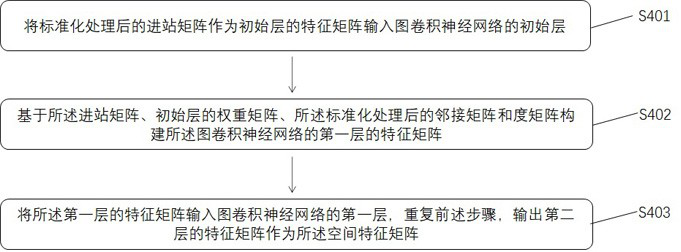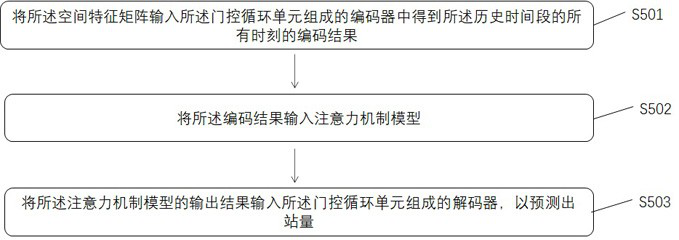Rail transit space-time short-time passenger flow prediction method, device and equipment and storage medium
A technology of rail transit and forecasting methods, applied in forecasting, biological neural network models, resources, etc., can solve problems such as inability to describe spatial correlation, and achieve the effect of eliminating the impact of dimensions and data value ranges
- Summary
- Abstract
- Description
- Claims
- Application Information
AI Technical Summary
Problems solved by technology
Method used
Image
Examples
Embodiment 1
[0092] Embodiment 1 This embodiment provides a rail transit space-time short-term passenger flow prediction method, such as figure 1 As shown, the method includes:
[0093] S1 obtains the inbound data and train schedule data in the historical time period;
[0094] S2 constructs an adjacency matrix based on travel time according to the train schedule data;
[0095] S3 standardizes the inbound data and the adjacency matrix to obtain a standardized inbound matrix and adjacency matrix;
[0096] S4 adopts the graph convolutional neural network to extract the spatial feature matrix of the inbound matrix and the adjacency matrix after the normalization process;
[0097] S5 uses a sequence-to-sequence model based on a gated recurrent unit and an attention mechanism to extract the time features of the spatial feature matrix to predict the outbound volume at the current moment.
[0098] A sequence-to-sequence model based on gated recurrent units is used to extract temporal features, ...
Embodiment 2
[0099] Embodiment 2 This embodiment provides a rail transit space-time short-term passenger flow prediction method, such as figure 1 As shown, the method includes:
[0100] S1 obtains the inbound data and train schedule data in the historical time period;
[0101] S2 constructs an adjacency matrix based on travel time according to the train schedule data;
[0102] S3 standardizes the inbound data and the adjacency matrix to obtain a standardized inbound matrix and adjacency matrix;
[0103] S4 adopts the graph convolutional neural network to extract the spatial feature matrix of the inbound matrix and the adjacency matrix after the normalization process;
[0104] S5 uses a sequence-to-sequence model based on a gated recurrent unit and an attention mechanism to extract the time features of the spatial feature matrix to predict the outbound volume at the current moment.
[0105] A sequence-to-sequence model based on gated recurrent units is used to extract temporal features, ...
Embodiment 3
[0166] Embodiment 3 This embodiment provides a method for predicting short-term passenger flow in rail transit space-time
[0167] The method includes the following steps:
[0168] S1: Obtain subway outbound passenger flow data at a granularity of 15 minutes according to the AFC system; construct an adjacency matrix based on train schedule data. Standardize the subway outbound passenger flow data and adjacency matrix to obtain the processed outbound matrix and adjacency matrix;
[0169] S2: Input the standardized subway outbound matrix and adjacency matrix data into the spatial feature extraction unit to extract the spatial features of passenger flow;
[0170] S3: Input the data after extracting the spatial features into the time feature extraction unit to extract the time features of the passenger flow;
[0171] S4: Combine the established spatial feature extraction unit and time feature extraction unit to predict, and obtain outbound volume and corresponding evaluation ind...
PUM
 Login to View More
Login to View More Abstract
Description
Claims
Application Information
 Login to View More
Login to View More - R&D
- Intellectual Property
- Life Sciences
- Materials
- Tech Scout
- Unparalleled Data Quality
- Higher Quality Content
- 60% Fewer Hallucinations
Browse by: Latest US Patents, China's latest patents, Technical Efficacy Thesaurus, Application Domain, Technology Topic, Popular Technical Reports.
© 2025 PatSnap. All rights reserved.Legal|Privacy policy|Modern Slavery Act Transparency Statement|Sitemap|About US| Contact US: help@patsnap.com



